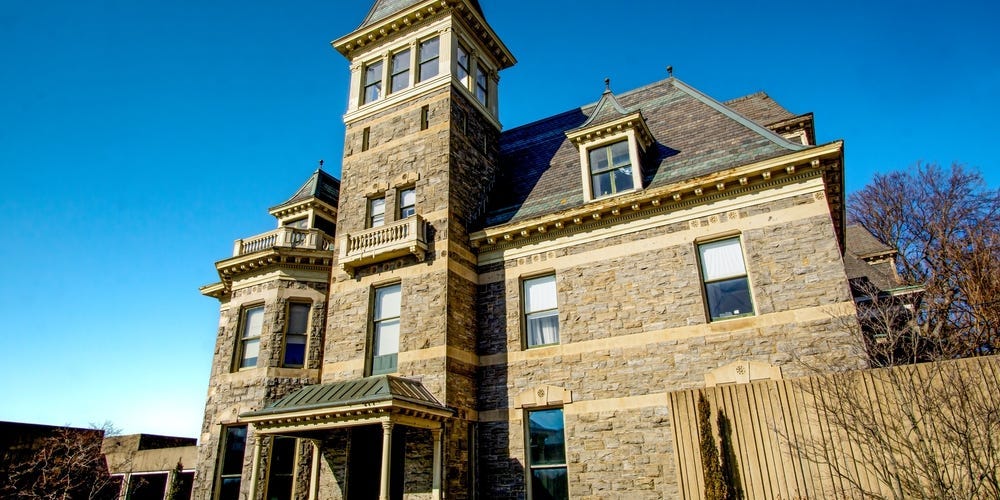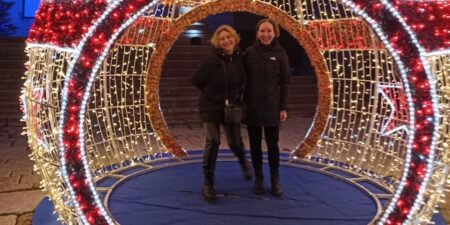X
Copy link
Impact Link
Save
Saved
Read in app
subscribers. Become an Insider
and start reading now.
Have an account? .
- Glenview is a Gilded Age mansion built by millionaire Wall Street banker John Bond Trevor in 1877.
- Visitors can tour the historic home located in Yonkers, New York.
- Glenview appears as Mrs. Astor’s house in HBO’s “The Gilded Age.”
For a limited time, fans of HBO’s “The Gilded Age” can see Mrs. Astor’s costumes from the show on display in the actual Gilded Age mansion where her scenes were filmed.
Glenview, a 19th-century seasonal home built for millionaire banker John Bond Trevor and his family, has been painstakingly restored by the Hudson River Museum in Yonkers, New York. Its ornate furnishings are so well-maintained that HBO used the mansion as a film set to portray Mrs. Caroline Schermerhorn Astor’s home on Fifth Avenue’s “Millionaires’ Row” in “The Gilded Age.”
Through October 6, Glenview will host an exhibit of costumes worn by Donna Murphy, who plays Astor in the series.
“Seeing the dresses in the context of Glenview’s period rooms will highlight the connections between our historic house and Gilded Age lifestyles of the Trevor family at Glenview and the Astors in New York City,” said Laura Vookles, who chairs the Hudson River Museum’s curatorial department.
As a fan of “The Gilded Age” and a historic mansion enthusiast, I visited Glenview in July to check out the costumes and learn more about the Trevor family’s life at the mansion. Take a look inside.
Glenview is located at the Hudson River Museum in Yonkers, New York.
The museum offers guided tours of Glenview from Wednesday through Sunday. Tickets cost $20 per adult and can be purchased on the Hudson River Museum’s website.
The home was constructed between 1876 and 1877 for John Bond Trevor, a millionaire banker and stockbroker who worked on Wall Street.
Trevor purchased the 23-acre estate in 1876 and hired architect Charles W. Clinton to design the home.
After his first wife died, leaving him with three children, Trevor moved into Glenview shortly after marrying his second wife, Emily Norwood Trevor.
The Trevors’ primary residence was in New York City, but they lived at Glenview from April to December each year. When in residence at Glenview, Trevor commuted into his office on Wall Street in New York City about 23 miles away.
Trevor died in 1890. Norwood remained in the home until her death in 1922, when it was then sold for $400,000, or around $7.6 million in 2025 when adjusted for inflation.
Our first stop on the tour was the Great Hall, where guests would enter the home.
The hall featured woodwork by Daniel Pabst, a Victorian furniture designer based in Philadelphia, and an encaustic tile floor designed by the English company Maw and Co.
A portrait of John Bond Trevor, seen right, is also on display in the hall.
Our guide pointed out an ornate calling card holder on an entryway table, where visitors would leave their information if the Trevors weren’t available.
During the Gilded Age, members of high society used calling cards to announce their visits and maintain their social standing. When visiting another home, guests would present cards with identifying information to a servant, who would bring them to the mistress of the house to determine if they would be allowed inside. If the mistress wasn’t available, guests would leave their cards on a tray.
The Great Hall also featured a grand staircase with the only two remaining original light fixtures in the home.
The lights were powered by gas because wealthy Gilded Age socialites believed that gas lighting was the most flattering to a woman’s complexion, our tour guide said. When Norwood Trevor descended the staircase to greet guests, she wanted to look her best for her grand entrance.
Once guests were admitted to Glenview, they were welcomed in the parlor.
Guests would have been greeted with live music. The couch and chairs in the parlor are original to the home. Other furnishings included Italian marble sculptures and a stuffed peacock in front of the fireplace.
The museum repainted the parlor’s ceilings with the original designs to restore it to the way it looked during the Gilded Age.
The wallpaper closely resembles the original design the Trevors chose as part of the Aesthetic Movement, which favored simpler, colorful geometric patterns over more ornate Victorian styles.
The parlor appeared in HBO’s “The Gilded Age” as Mrs. Astor’s house, and features some of her costumes for a limited-time exhibition.
The Hudson River Museum has costumes from “The Gilded Age” worn by Donna Murphy, who portrays Mrs. Astor, on display at Glenview through October 6.
We proceeded into the Ebony Library, which was Trevor’s domain as the man of the house.
Trevor used the library as his study. The wooden cabinetry and fireplace were not made of actual ebony wood, but ebonized cherry wood made to look darker.
Fans of “The Gilded Age” may recognize the fireplace from a scene in season one where Mrs. Astor tosses a party invitation from Mrs. Russell into the fire.
The ceiling was decorated with chrysanthemums, a symbol of power used by Japan’s imperial family.
Chrysanthemums appear throughout Glenview, carved into the bricks of the home’s exterior and in the pillars on the Grand Staircase.
Next door, the sitting room served as Norwood Trevor’s area for entertaining as well as a family room.
The room’s curved floor-to-ceiling windows were a status symbol of wealth in the Gilded Age due to the high price of glass.
Its windows looked out onto stunning views of the Hudson River.
The original home featured a wraparound balcony that could be accessed through the Sitting Room, but it was later removed in order to lower maintenance costs.
The ceiling was decorated with more feminine floral patterns than the Ebony Library.
Our tour guide said that Norwood Trevor was “obsessed with little gestures of hospitality,” and chose the pattern to ensure that women who entered the room felt as comfortable and at home as possible.
A display case featured Mary Trevor’s wedding portrait and a fan she held on her wedding day.
In 1892, the Trevors hosted the wedding reception of their oldest daughter, Mary Trevor. She married Grenville Winthrop, a Harvard Law graduate and attorney, in the Parlor of Glenview.
A chair with a unique detail proved that Trevor also spent time in the sitting room.
An original chair in the sitting room featured a button on the arm that allowed it to recline. It was considered unseemly for women to lounge during the Gilded Age, so it would have only been used by Trevor.
The dining room featured another costume from “The Gilded Age,” as well as a decorative panel to hide the entrance to the kitchen where servants worked.
The dining room could seat anywhere from 11 to 18 people for dinner.
The medieval-style furnishings included walnut wainscoting along the walls and painted ceilings.
The dining room features the only remaining original ceiling paintings at Glenview.
A sideboard, also designed by woodworker Daniel Pabst, included a nod to one of Aesop’s fables about how to be a gracious host.
In the fable of the fox and the crane, the fox invites the crane for dinner and serves food in a shallow bowl, which the crane can’t eat because of its beak. The crane then invites the fox for dinner and presents food in a tall glass, which the fox can’t reach with its short snout. The moral of the story is to be hospitable and accommodating to guests.
We ended the tour by returning to the Great Hall, where we stopped by an ornate tiled fireplace.
A row of tiles above the fireplace depicted fairytales such as Beauty and the Beast and Rumpelstiltskin, which children could point to and indicate which story they’d like to hear. The bottom of the fireplace showed Guinevere, the wife of the legendary King Arthur.
Glenview’s Gilded Age grandeur isn’t just for fans of the show — it’s for anyone who enjoys history, architecture, and a taste of the finer things in life.
Even if you haven’t seen “The Gilded Age,” visiting Glenview provides a look into the lives of Gilded Age millionaires outside of New York City, where seasonal estates provided an escape during the warmer months and small gestures of hospitality helped visitors feel at home.
Read the full article here
















